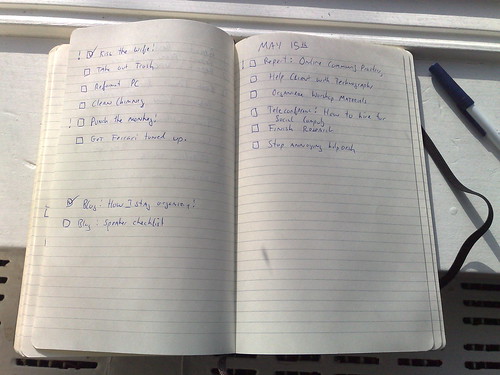Above Image: I use the Large Ruled Notebook by Moleskine.
I’ve got a pretty intense schedule, in the past I’ve written about the many tasks of an analyst in the day job, and I also spend time being in the conversation by maintaining this blog, being active on twitter, maintaining communities in Facebook, and attend many events. I’ve got a personal life, spend time at the gym, am a husband, and have a social circle that’s not even connected to the tech world.
Technology isn’t always the answer to everything, in fact I actually don’t use a digital device as they take too long to input, aren’t always available, are fragile, and there are risks of battery life limitations and data loss, so I use paper.
Here’s how I stay organized:
I use a Moleskine, the medium size in fact, but any book will do.
I use two pages each week (or more often) to organize my tasks.
For every task, I create a small checkbox, for items that are urgent, Ill mark with an “!” mark. As I complete tasks, I’ll check them off. Just about every week I’ll recreate the list, reprioritize, and consolidate. I find that writing the tasks down actually helps with me subconsciously brainstorming, and reviewing you go to bed at night is a great way to put your internal employee (your unconscious mind) to work. This is why you’ll often notice my blog posts come in the early morning, I sort my problems at night.
On the top left column, I list out all of my personal tasks to take care of, house, car, bills, important dates, medical issues that need to be dealt with.
On the lower left I list out blog ideas, (you never know when you’ll get them) it’s important I write these down, as sometimes I’ll forget, and that’s very frustrating. Both of these rarely exceed the whole page.
Now on the right hand column, this is dedicated to my work requirements, and it quickly fills up the half of the page in no time.
When I see more than 10 tasks, I know it’s time to start to really focus by prioritizing, turning off distractions, and hunkering down to get my work down.
This process has been working well for me, although I’m not a star analyst, I’m meeting the requirements of a new analyst, and so far, I’ve not dropped too many personal tasks.
Related:
Pay yourself first, one thing leads to another Manage your time as you do money
I’d love to hear from you, how do you keep organized?
Update: Ran across this related video

I use Remember the Milk: http://www.rememberthemilk.com
I use something similar for work. I like the one page a day calendars. If I don’t finish something, I just carry it over to the next day.
paper! I too use a notebook (not a Moleskin) and actually store them as reference.
guess the new gig is working out well if “tune up a Ferrari” is on the to-do list.
and, there is no way I’m going to comment on the “kiss the wife” task, and how sad it is you actually have to write it down. or, how you even did it yesterday when you were traveling.
I keep organised by having a whiteboard hanging on top of my desk and having several coloured markers handy. It’s great! There has been more than a few times where a great idea would come to my head when I’m about to sleep and I would just go up, turn on the light and record this idea on the whiteboard. I’m a fairly visual person so this whiteboard is great.
Another great tool is Microsoft OneNote to organise notes. I used to just save it all in a bunch of a .doc’s but it’s not effective.
I use Remember the Milk: http://www.rememberthemilk.com